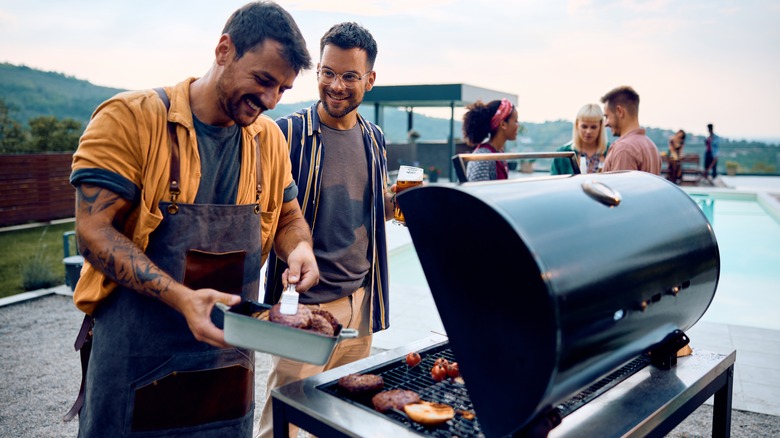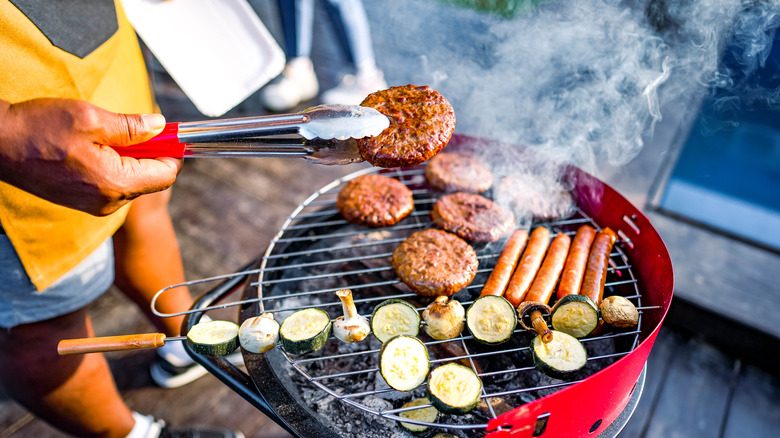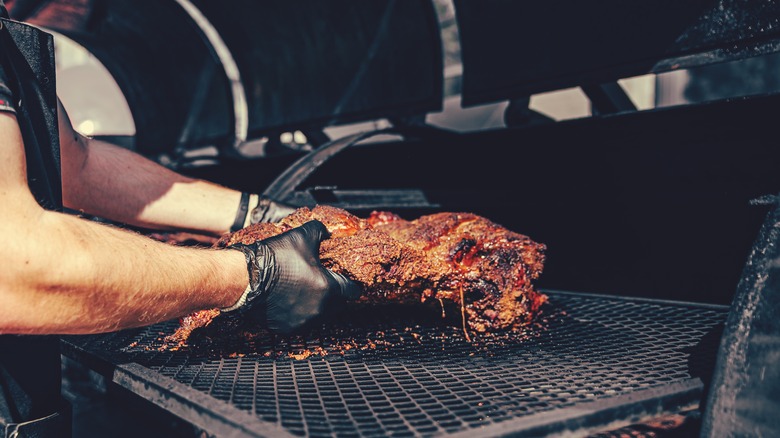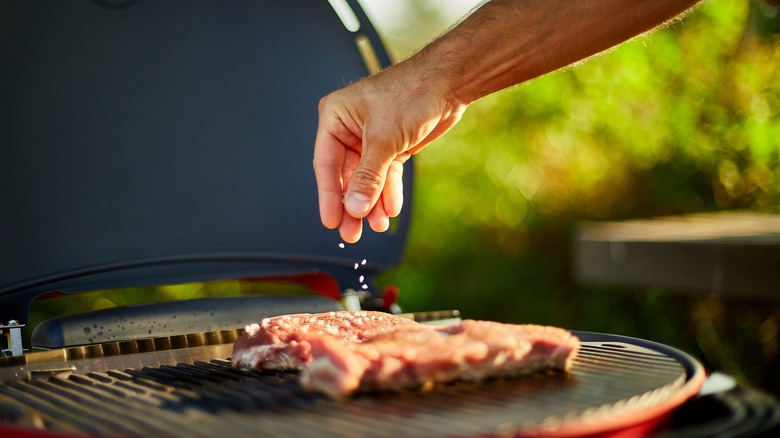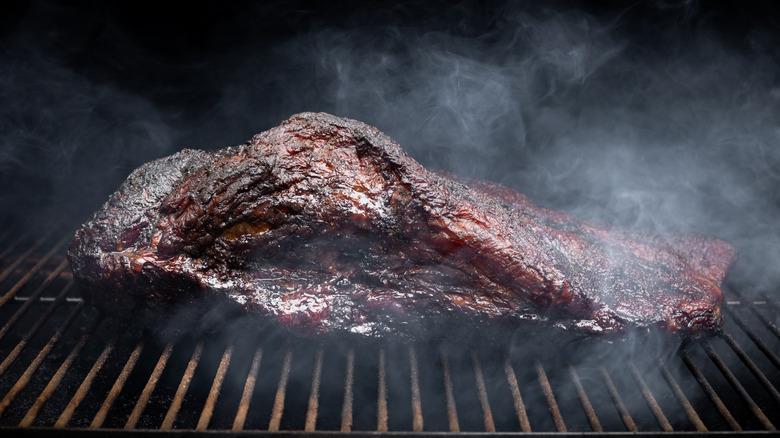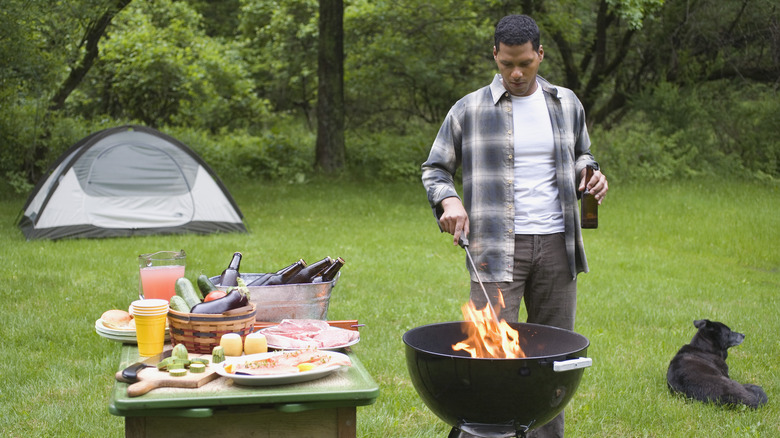Grilling Vs Barbecuing: Differences And Tips For A Delicious Outdoor Feast
Summer means that people will not only be spending more time outside, but will be spending more time cooking outside. Whether at home on your patio or deck or at a campsite, the warm weather months are a perfect time for grilling and barbecuing. According to Statista, these activities reach their zenith each year over the Fourth of July holiday. While these terms are often used interchangeably, they are actually two distinctly different types of cooking.
To be sure, there are many similarities. Both are done outdoors, use wood or charcoal as a heat source, involve putting meat on a metal rack, and utilize some sort of containment device made from brick, concrete, stone, or metal for the coals. However, one involves cooking the meat with direct heat, while the other uses indirect heat and smoke. There is also a substantial difference in the time it takes for the food to cook. While this difference may seem trivial and appear to be a simple manner of semantics, it actually makes a major difference in what type of meat can be cooked and how that meat will taste.
What is grilling?
Grilling, which involves cooking relatively quickly over direct heat, is the more common method of outdoor cooking. Charcoal briquets are commonly used for grilling, but the heat for grilling food may actually come from a variety of sources, including gas, electricity, charcoal, or wood. Pellet grills, which are becoming increasingly more common and popular, utilize a combination of electricity and pellets formed from compressed wood to supply heat. Regardless of the type of grill used, grilling refers to placing the food directly over the heat source in order to cook it.
The temperature at which the food is cooking is typically higher than what is used when barbecuing. So, grilling is a quick-cooking technique. That affects the choice of foods which can be effectively cooked by grilling. Typically, foods for grilling would include things like burgers, hot dogs, sausage, shrimp and fish, vegetables, steaks, fajitas, and some chicken or ribs. Skewers combining a variety of these food types are also commonly grilled.
What is barbecuing?
In some ways, barbecuing is almost the exact opposite of grilling. When barbecuing, the meat is placed in an enclosed pit away from the heat source. This indirect heat fills the pit, typically at a temperature of under 250 degrees, which means food takes more time to cook. This is where the old barbecue adage low and slow comes from –- slow cooking over low heat.
A variety of wood can be used to barbecue. After being lit, the wood will be reduced to glowing coals, which provide the heat for cooking (charcoal briquets can also be used). In order to ensure the heat is indeed indirect, many larger barbecue pits are fitted with a fire box. These are known as offset cookers or pits. When set up, the firebox contains burning wood and coals. The heat from the firebox is radiated into the cooking chamber via an air draft. If you do not have an offset cooker, you can still use indirect heat by placing your coals to one side of your pit or in a ring with an empty center.
So, which meats are best for BBQ? Actually, it is more of barbecuing the right way to cook these meats, as the low and slow technique was developed because it was the best way to cook what had previously been seen as tough, undesirable cuts of meat. Good choices for BBQ include beef brisket, pork butt, chicken (whole or quarters), and ribs.
Tips for grilling
When it comes to grilling up a meal for yourself, family, or friends, there are a few things you can do to enhance the end result. One of the simplest is to keep the grill clean. Use a metal brush to clean the grill each time before using it in order to remove any residual food, soot, or grease. It is good to brush off the grill prior to lighting the pit as well as once the grill has heated up. This will not only make your meal taste better, but will also keep your food from sticking to the grill while cooking. Preheating your grill can also improve your end result, as it will ensure an even cooking temperature and prevent sticking.
You can also enhance the flavor of your grilled food by paying attention to how you start your fire. Almost everyone agrees that using lighter fluid, while common, is a big mistake. Even though it burns, the essence of lighter fluid tends to linger and can taint the taste of your grilled food. Instead, use a coal chimney or non-chemical fire starters.
Picking the right types of foods –- those that can effectively be cooked quickly with high heat — is another way to make sure your grilled meal comes out tasty. Utilizing foil as a heat barrier or to make a flavor packet is another good grilling hack.
Tips for barbecuing
If you want to try your hand at barbecuing instead of grilling, there are a few things that you should do in order to make sure your food comes out the way it should. Some of these things are the same as if you are grilling. For example, keeping the grill clean, not using a lighter, and preheating the pit. One of the main things for mastering the low and slow method necessary to make good barbecue, however, is realizing it takes a long time! You need to keep the temperatures where it needs to be and allow the meat time to properly cook.
But, if you really want your backyard barbecue to taste like that of your favorite barbecue stand or restaurant one of the main things you need to do is use the right type of wood. Because meat sits on the barbecue pit for so long, it absorbs the scent, smell, and taste of the smoke from the wood that is being used to cook it. That can be a positive or a negative, which is why it is important to pick a wood that produces the proper smoke to pair with the meat you're cooking.
Staying safe while grilling or barbecuing
While outdoor cooking can be an enjoyable activity, it can also be hazardous. Unfortunately, each year thousands of accidents and fires happen while people are grilling or barbecuing. This is not necessarily a surprise when you consider both types of cooking involve fire and are often done by those who are inexperienced with these activities. However, whether you are grilling for the first time or are a seasoned pitmaster, there are steps you should take to stay safe while grilling or barbecuing.
There are a variety of nuanced safety tips depending on the type of pit or grill you are using. However, some universal safety precautions for grilling or barbecuing are nicely outlined by StaySafe.org and include:
- Place the grill or pit a safe distance from any structure — house, porch, tent, etc.
- Never use a pit or grill in an enclosure such as a garage.
- Keep children away from the grill.
- Do not use gasoline to light the pit.
- If you are using lighter fluid, do not reapply once the pit is lit.
- Keep a fire extinguisher and/or fire hose handy.
- Never leave the grill unattended.
